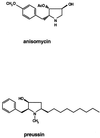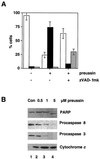Inhibition of cyclin-dependent kinase activity and induction of apoptosis by preussin in human tumor cells
- PMID: 10991862
- PMCID: PMC90153
- DOI: 10.1128/AAC.44.10.2794-2801.2000
Inhibition of cyclin-dependent kinase activity and induction of apoptosis by preussin in human tumor cells
Abstract
In this paper, we report that (+)-preussin, a pyrrolidinol alkaloid originally identified as an antifungal agent, has growth-inhibitory and cytotoxic effects on human cancer cells. Preussin was found to be a potent inhibitor of cyclin E kinase (CDK2-cyclin E) in vitro (50% inhibitory concentration; approximately 500 nM) and to inhibit cell cycle progression into S phase. In agreement with these findings, the level of the cyclin-dependent kinase inhibitor p27(KIP-1) is increased in response to preussin treatment while the expression of both cyclin A and the transcription factor E2F-1 is down-regulated. Preussin also induces programmed cell death (apoptosis), which requires caspase activation and involves the release of cytochrome c from mitochondria. This induction of apoptosis is not blocked by high levels of Bcl-2, which usually confers resistance to chemotherapeutic agents. Taken together, our data indicate that preussin could be a promising lead compound for the development of a new class of potent antitumor drugs.
Figures









References
-
- Arguello F, Alexander M, Sterry J A, Tudor G, Smith E M, Kalavar N T, Greene J F, Koss W, Morgan C D, Stinson S F, Siford T J, Alvord W G, Klabansky R L, Sausville E A. Flavopiridol induces apoptosis of normal lymphoid cells, causes immunosuppression, and has potent antitumor activity In vivo against human leukemia and lymphoma xenografts. Blood. 1998;91:2482–2490. - PubMed
-
- Ausubel F M, Brent R, Kingston R E, Moore D D, Seidman J G, Smith J A, Struhl K, editors. Current protocols in molecular biology. Vol. 2. Boston, Mass: John Wiley & Sons, Inc.; 1995.
-
- Bach T, Brummerhop H. Ungewöhnliche faciale Diastereoselektivität in der Paternò-Büchi-Reaktion eines chiralen Dihydropyrrols—eine kurze Totalsynthese von (+)-Preussin. Angew Chem. 1998;110:3577–3579.
-
- Bible K C, Kaufmann S H. Cytotoxic synergy between flavopiridol (NSC 649890, L86-8275) and various antineoplastic agents: the importance of sequence of administration. Cancer Res. 1997;57:3375–3380. - PubMed
-
- Bible K C, Kaufmann S H. Flavopiridol: a cytotoxic flavone that induces cell death in noncycling A549 human lung carcinoma cells. Cancer Res. 1996;56:4856–4861. - PubMed
Publication types
MeSH terms
Substances
LinkOut - more resources
Full Text Sources

